Topics 2018
November 2018
Nov. 30, 2018 Updated
Launch of Epsilon-4 with the Innovative Satellite Technology Demonstoration-1 on Board
|
JAXA announces that the Epsilon 4 launch encapsulating the innovation satellite technology is scheduled on January 17, 2019. The launch window is 9:50:20 a.m. through 9:59:37 a.m., in Japan Standard time. |
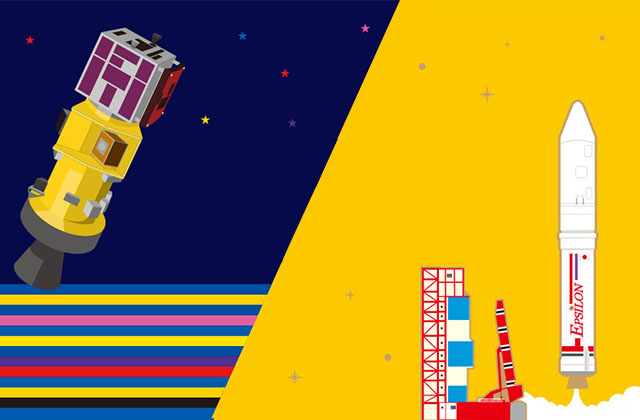
|
|---|
Nov. 19, 2018 Updated
The HTV7 Return Capsule Brought to the JAXA Tsukuba Space Center
|
At approximately 4 pm, January 17, the HTV7 return capsule was delivered to the JAXA Tsukuba Space Center. |

|
|---|
Nov. 13, 2018 Updated
Test Equipment in the HTV7 Return Capsule at the JAXA Tsukuba Space Center
|
At 9:42 am Today, Tuesday November 13, the sample collection capsule onboard the cargo transporter Kounotori (HTV7) was delivered to the JAXA Tsukuba Space Center. 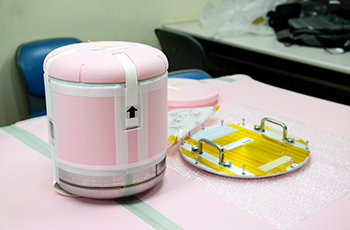
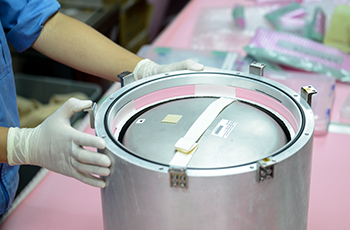
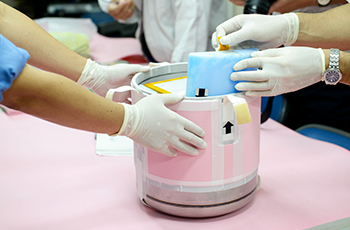
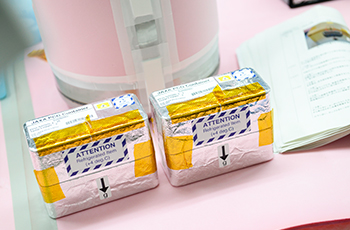
|
Nov. 12, 2018 Updated
The HSRC Recovered from the Ocean
|
At 7:06 am, Sunday November 11, the HTV Small Re-entry Capsule (HSRC) splashed down. 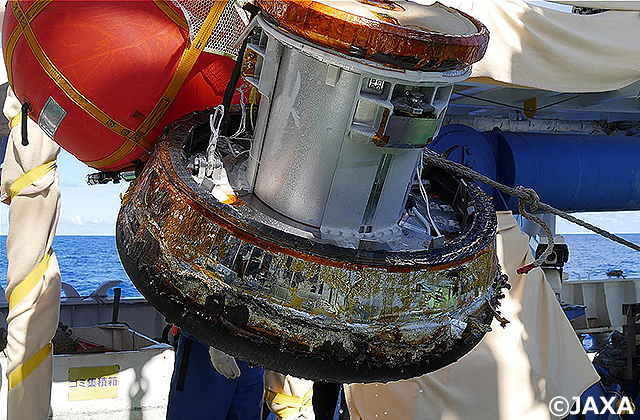 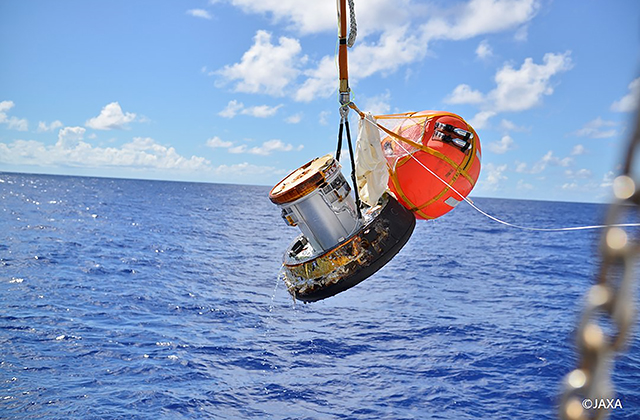
|
Nov. 8, 2018 Updated
HTV7 Departs from ISS
|
Alexander Gerst used the robotic arm to release the HTV transfer vehicle-7 (HTV7) at 1:50 am, November 8. Robotics ground controllers used the Station Remote Manipulator System (SSRMS) to unberth the HTV7 from the international outpost of the International Space Station. (ISS) HTV7’s thrusters were fired to move the spacecraft a safe distance from the station. |
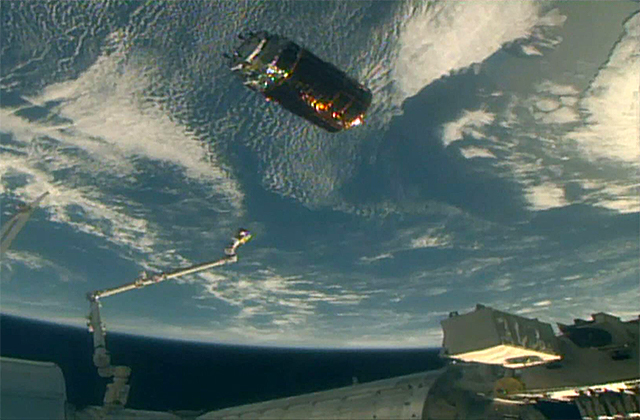
|
|---|
Nov. 7, 2018 Updated
HTV7 Set for Departure from ISS
|
The HTV Small Re-entry Capsule (HSRC) with experiment samples on board was attached onto the hatch of the pressurized logistic carrier of the HTV transfer vehicle-7 (HTV7) at 0:26 am, November 7, the process readying the HTV7 to unberth from the International Space Station. (ISS) JAXA Astronaut Takuya Onishi was among the ground controllers who gave commands from the JAXA Tsukuba Space Center. Onishi rejoiced together with the ground control teams of Kibo and HTV that this phase of the HTV7 mission was now completed. JAXA will cover the HTV7 departure from the ISS live from 1:20 am, November 8. Share the moments with us. 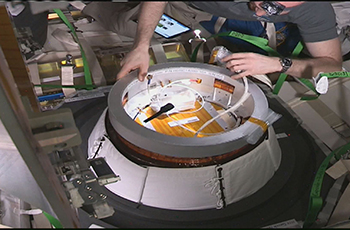
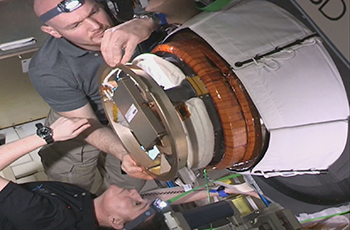
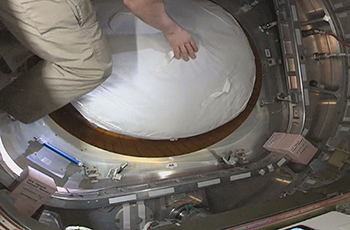
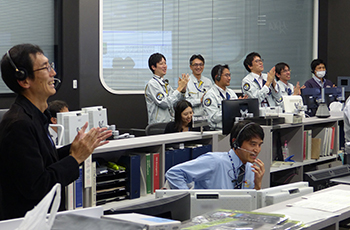
|
Nov. 1, 2018 Updated
Extention of the domain of JAXA Realtime Rainfall Watch (GSMaP_NOW)
|
JAXA has operated the "JAXA Realtime Rainfall Watch" website and the product "GSMaP_NOW" from November 2015, which provides "realtime" rainfall information within GEO-satellite Himawari domain. 
Fig.1 Domain of GSMaP_NOW. |
October 2018
Oct. 29, 2018 Updated
Take the "Satellites Observing the Globe" tour on Google Earth Discover amazing facts about rockets and satellites From Monday, October 29, 2018
|
JAXA releases the Story at guide tour "Voyager" on "Google Earth" provided by Google. The Story tells you about the launch of the rocket or JAXA's satellites easily and visibly so that everyone, from children to adult, can enjoy learning them. |
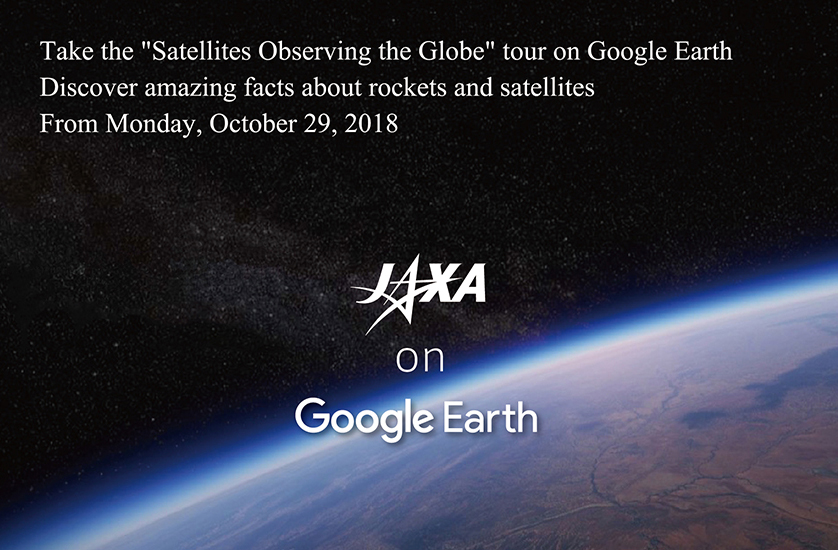
|
|---|
Oct. 20, 2018 Updated
MIO En Route to Mercury
|
BepiColombo mission successfully took off at 10:45:28 am, October 20, in Japan Time, 2018. From the Guiana Space Center in French Guiana, the ESA's Mercury Planetary Orbiter (MPO) and JAXA's MIO, Mercury Magnetospheric Orbiter were launched aboard the Ariane 5 rocket at 10:45:28 pm in local time, 2018.
|
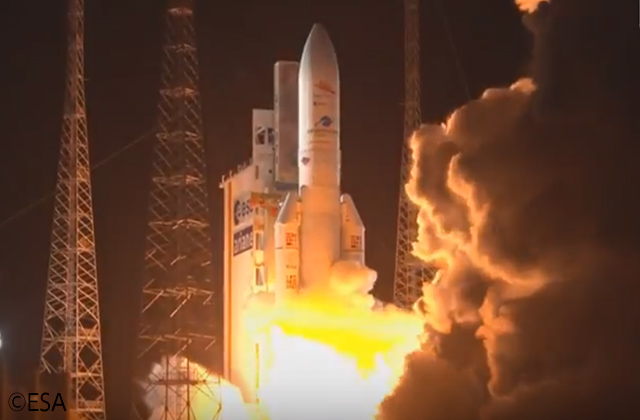
|
|---|
Oct. 19, 2018 Updated
BepiColombo Live Launch Coverage Starts at 10 AM Saturday, October 20
|
MPO, Mercury Planetary Orbiter, developed by the ESA, European Space Agency and MIO, JAXA’s Mercury Magnetospheric Orbiter will launch onboard Ariane 5 rocket at 10:45:28 am, October 20 in Japan Time. (10:45:28 pm in local French Guinea Time) |
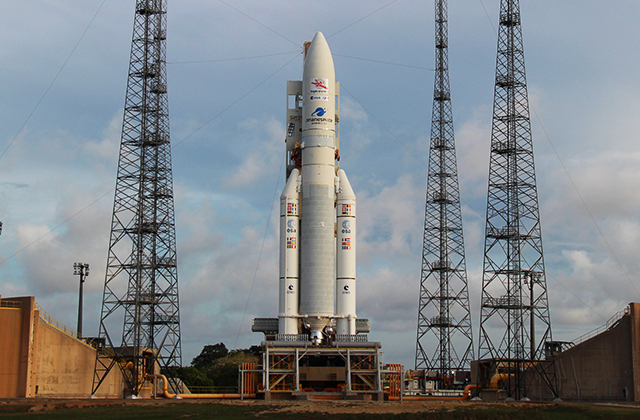
|
|---|
Oct. 15, 2018 Updated
Sample Data of GCOM-C Standard Product Available on G-Portal
|
Launched on December 23, 2017 from the JAXA Tanegashima Space Center, Global Change Observation Mission – Climate (GCOM-C) entered and completed its in-orbit checkout phase, during which the science instruments and satellite systems are evaluated. The in-orbit checkout mission was through by March 2018, ensuring the product verification. |
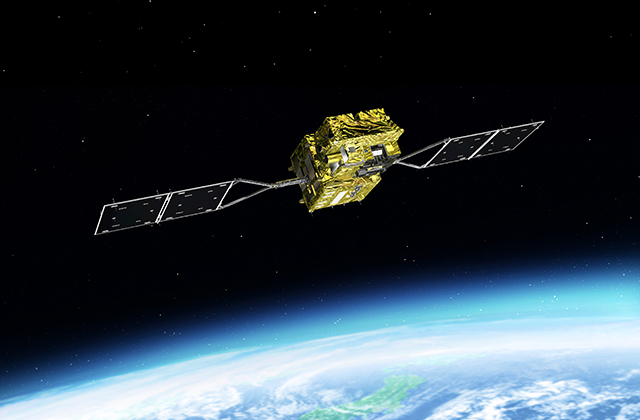
|
|---|
Oct. 3, 2018 Updated
Memorandum of Understanding with National Aeronautics and Space Administration (NASA) for cooperation on the X-Ray Imaging and Spectroscopy Mission: XRISM
|
The Japan Aerospace Exploration Agency (JAXA) and the National Aeronautics and Space Administration (NASA) have agreed to cooperate on the X-Ray Imaging and Spectroscopy Mission: XRISM. On October 2, 2018, Hiroshi Yamakawa, President of JAXA, and Jim Bridenstine, Administrator of NASA, signed a Memorandum of Understanding in Bremen, Germany.
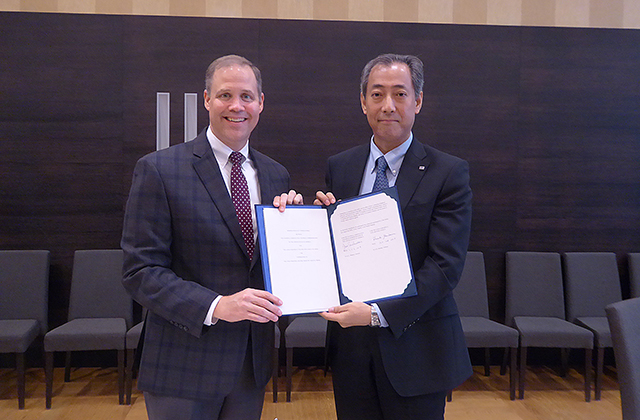
|
Oct. 2, 2018 Updated
UNOOSA and JAXA open Fourth Round of KiboCUBE!
|
Japan Aerospace Exploration Agency (JAXA) and the United Nations Office for Outer Space Affairs (UNOOSA) is pleased to announce the opening of the fourth round of KiboCUBE.
Please refer to the following website for further details regarding the applications for the KiboCUBE fourth round (“Announcement of Opportunity”). The application due date is January 31. We look forward to receiving many applicants and contributing to the capacity building of your country! Application details: (Reference 1) (Reference 2) Results of past selection 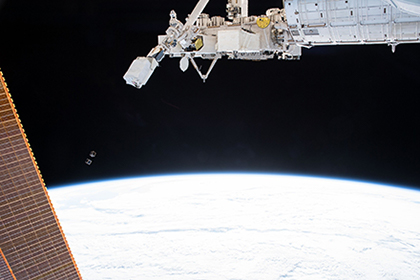
Successful deployment of 1KUNS-PF (Kenyan Satellite, selected as first round of KiboCUBE) from Kibo in May, 2018 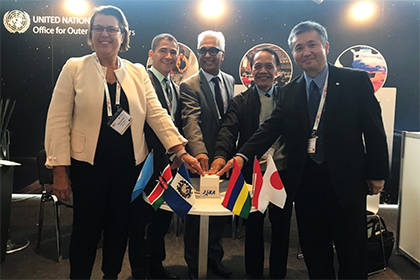
Media Briefing at IAC 2018 in Bremen, Germany on October 1st, 2018. Representatives from the selected entities for second and third round of KiboCUBE gathered for the media briefing. (from left) Ms. Simonetta DiPippo, UNOOSA; Mr. Luis Zea, Universidad del Valle de Guatemala; Dr. Arjoon Suddhoo, Mauritius Research Council; Mr. Sunartoto Gunadi, Surya University of Indonesia; Dr. Koichi Wakata, JAXA |
||||||||||||||
September 2018
Sep. 23, 2018 Updated
KOUNOTORI7/H-IIB F7 Successfully Launched
|
The H-IIB Launch Vehicle No. 7 with cargo transporter to the International Space Station, the KOUNOTORI7 (HTV7) aboard lifted off from the Tanegashima Space Center at 2:54:27 on September 23. (Japan Standard Time) |
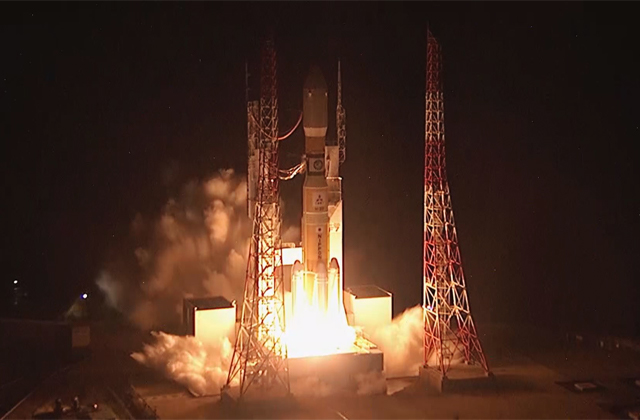
|
|---|
Sep. 10, 2018 Updated
Revision of the Cooperation Agreement between the Japan Aerospace Exploration Agency (JAXA) and the Vietnam Academy of Science & Technology (VAST) Concerning Space Development and Application.
|
Dr. Hiroshi Yamakawa, President of the Japan Aerospace Exploration Agency (hereinafter referred to as JAXA), and Prof. Dr. Chau Van Minh, President of the Vietnam Academy of Science & Technology (hereinafter referred to as VAST), signed the revised the “Agreement Concerning Examination and Definition of Potential Cooperation on Space Development and Application". 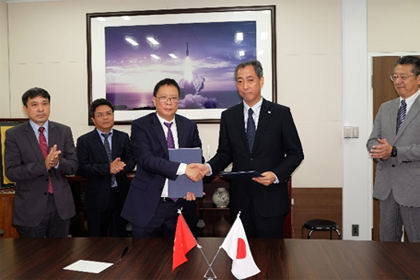
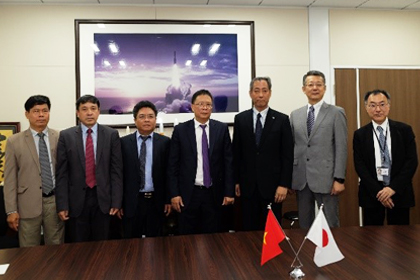
|
Sep. 7, 2018 Updated
NASA-JAXA Joint Statement on Collaborative Efforts for Lunar Exploration and Beyond
|
On August 27, 2018, the Japan Aerospace Exploration Agency (JAXA) and the National Aeronautics and Space Administration (NASA) signed a “Joint Statement on Collaborative Efforts for Lunar Exploration and Beyond.”
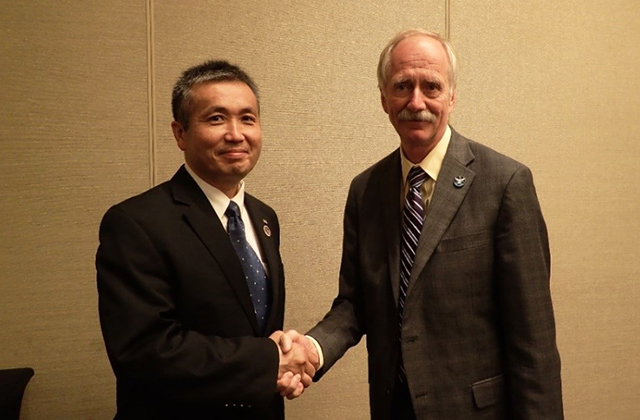
JAXA Mr.Koichi Wakata (left) and NASA Mr.William H. Gerstenmaier (right)
Presenters |
Sep. 7, 2018 Updated
Symposium celebrating the 160th anniversary of diplomatic relations between France and Japan. "Exploring space together: Astronauts' point of view"
|
We will hold a symposium themed France-Japan Space Cooperation as part of the 160th anniversary of diplomatic relations between France and Japan.
Outline
Program |
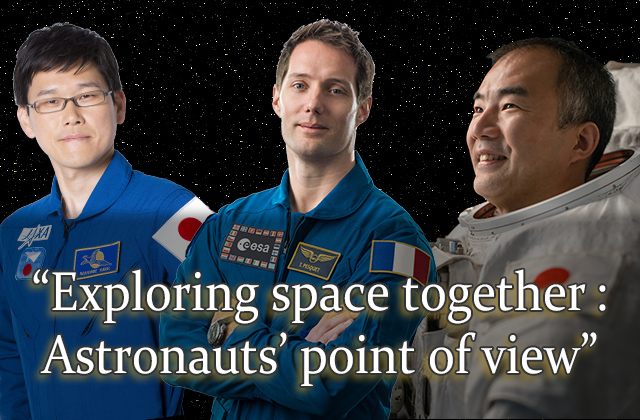
|
|---|
July 2018
Jul. 25, 2018 Updated
Imaging Ryugu from an altitude of 6km
|
Hayabusa2 arrived at asteroid Ryugu on June 27, after which the spacecraft remained at a distance of about 20km (the Home Position) to continue to observe the asteroid. During this time, the spacecraft was maintaining a hovering altitude of 20km above the asteroid surface. Figure 1: ※Please use the displayed credit when reproducing these images. In the case where an abbreviated form is necessary, please write "JAXA, University of Tokyo & collaborators". |
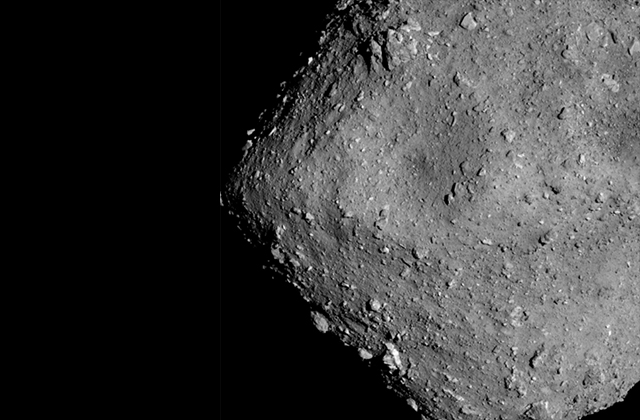
|
|---|
Jul. 17, 2018 Updated
Bremen Town Hall Exhibits Hayabusa2 and Mascot, July 10 to October 14
|
The Bremen City Hall, Bremen, Germany houses on exhibit the JAXA asteroid explorer Hayabusa2, and MASCOT, the onboard lander MASCOT, developed by DLR (Deutsches Zentrum für Luft- und Raumfahrt, English: The German Aerospace Center) and CNES (The Centre National d’Etudes Spatiales, English: French National Centre for Space Studies). The City Hall, UNESCO World Heritage Site accommodates the exhibits July 10 through October 14. At 9:35 am Japan Time, June 27, Hayabusa2 rendezvoused with Ryugu, the target asteroid. Keeping its 20-kilometer distance away from the asteroid, or its home position, Hayabusa2 is being confirmed of its function that performs future operations. MASCOT will land on the asteroid around October this year for observations of the surface using four instruments. 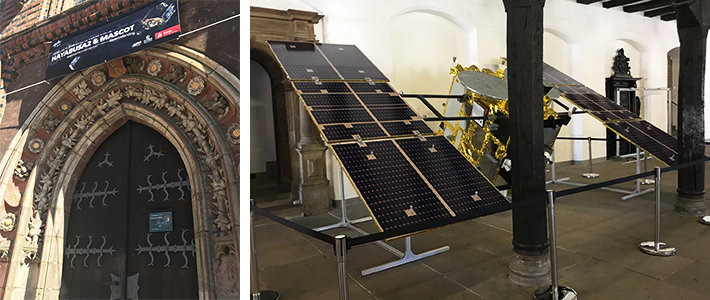
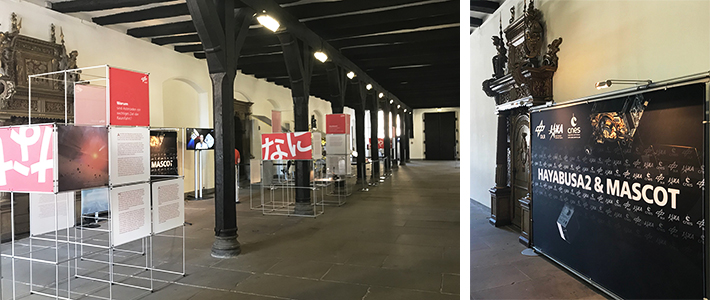
|
Jul. 10, 2018 Updated
Participation of JAXA President in UNISPACE+50
|
The United Nations Office for Outer Space Affairs (UNOOSA) organized UNISPACE+50 from June 18th to 21st, 2018 in Vienna International Center, Austria to celebrate the fiftieth anniversary of UNISPACE I (Reference 1). More than 70 countries and organizations, and participants from ministerial level (14 participants) and heads of agencies (10 participants) participated in the conference. Ambassador Kitano, Permanent Representative and Ambassador Extraordinary and Plenipotentiary of Japan to the International Organizations in Vienna represented the Japanese delegation. Dr. Yamakawa, JAXA President, also participated in the conference. During the high-level segment of UNISPACE+50, Dr. Yamakawa represented Japan and made a statement regarding Japan's recent space activities. He also delivered a speech during the Heads of Agencies Panel, and introduced JAXA's contributions to SDGs. He had meetings with various space agencies and signed two agreements—agreement regarding the extension of KiboCUBE cooperation programme with UNOOSA, and an implementation agreement concerning cooperation on validations, improvement, and applications of rainfall products using satellite images and ground measurements with Indian Space Research Organization (ISRO). (Reference 2,3) 


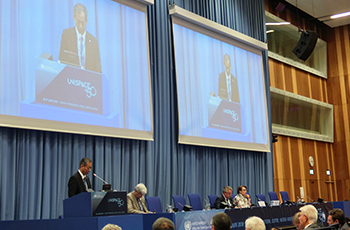
|
Jul. 6, 2018 Updated
JAXA’s ALWIN Earned President’s Award of the Japan Aeronautical Engineers Association
|
ALWIN, Airport Low-level Wind Information was prized with the President's award of the Japan Aeronautical Engineers Association. Since last April, the award-winning technology, co-developed by JAXA and Japan Meteorological Agency, has been in operation at Haneda and Narita International airports. |
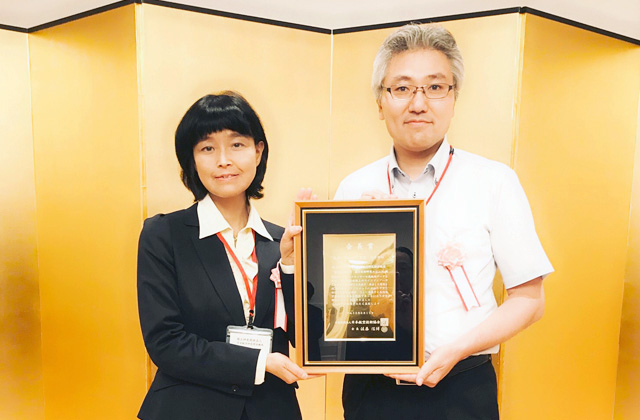
|
|---|
Jul. 6, 2018 Updated
Bronze Lion to Future Cuisine Restaurant Ibuki in 65th Cannes PR Lions
|
Slated for launch in Japanese fiscal 2018, JAXA's GOSAT-2, Greenhouse Gases Observing Satellite: later renamed Ibuki is designed to accurately measure carbon dioxide and methane concentrations. This high-resolution satellite data is expected to offer consistent information that helps identify the sources of emission and absorption of atmospheric carbon monoxide. 
|
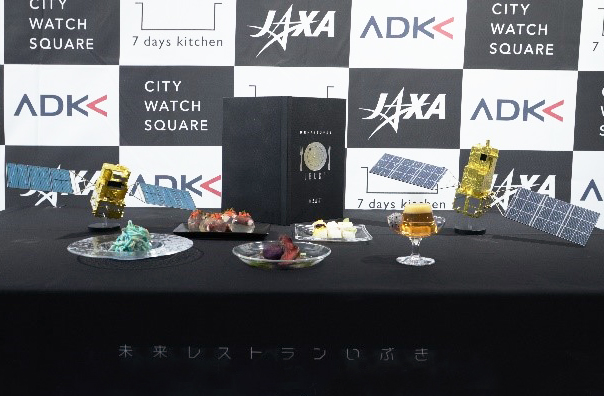
|
|---|
Jul. 4, 2018 Updated
Stereo image of asteroid Ryugu by Dr. Brian May
|
Brian May, the lead guitarist from the British rock band, Queen, has created a stereoscopic image of Ryugu from photographs captured with the ONC-T camera onboard Hayabusa2, so that the asteroid can be viewed in three dimensions. Brian May is an astronomer, with a doctoral degree in astrophysics from Imperial College London. He has a strong interest in planetary defense or space guard, which considers the potential threat to the Earth from meteorites. As part of this, May is a core member of "Asteroid Day", that began about three years ago to increase awareness of asteroids and action that can be taken to protect the Earth. |

|
|---|
Jul. 3, 2018 Updated
Introduction to Polarization observation and Near Ultraviolet observation by SGLI
|
The Second Generation Global Imager (SGLI) instrument aboard the JAXA satellite Global Change Observation Mission-Climate (GCOM-C) is an optical sensor capable of observations at wavelengths ranging from near ultraviolet to thermal infrared (380nm to 12µm). SGLI can observe the polarization state of light in red and near infrared band by switching to directional angles from +45deg (forward) and -45deg (backward). Polarization measurement can provide the properties of light including the oscillation direction of electromagnetic waves, in addition to the magnitude of light.
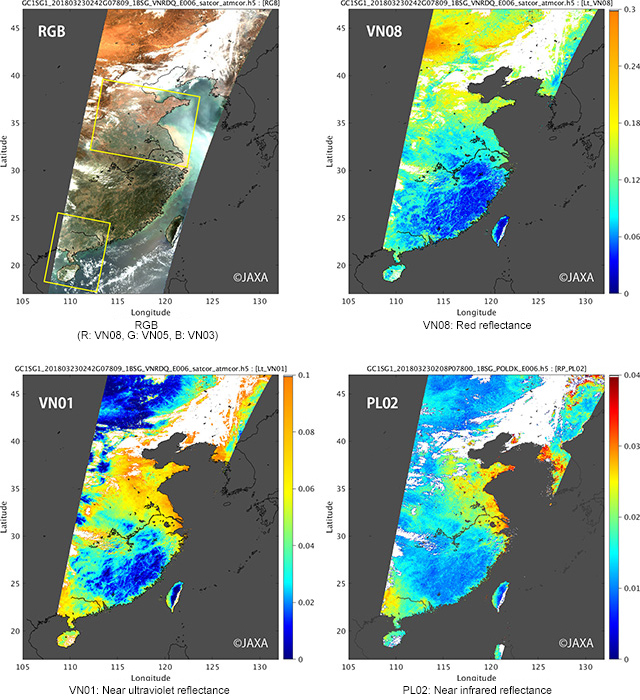
Images: |
June 2018
Jun. 29, 2018 Updated
Arrival at Ryugu!
|
1302 days after the launch from Tanegashima Space Center on December 3, 2014, 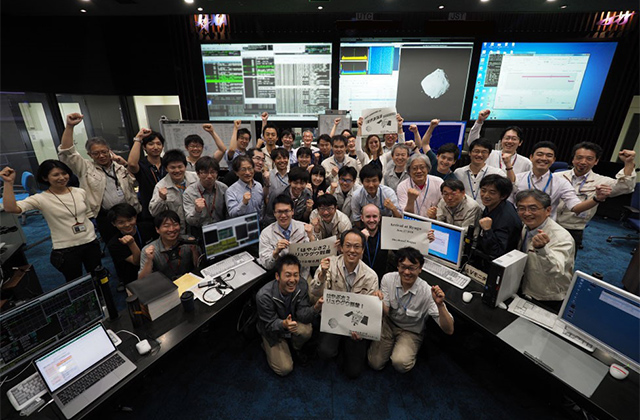
Figure: Group photo commemorating arrival at Ryugu. This is our triumphant pose (known as the "guts pose" / ガッツポーズ in Japanese). |
Jun. 25, 2018 Updated
Asteroid Ryugu seen from a distance of around 40km
|
Hayabusa2 is close to arriving at asteroid Ryugu. After a journey of around 3.2 billion km since launch, our destination is finally near. Two small objects will soon meet in outer space 280 million km from the Earth. |
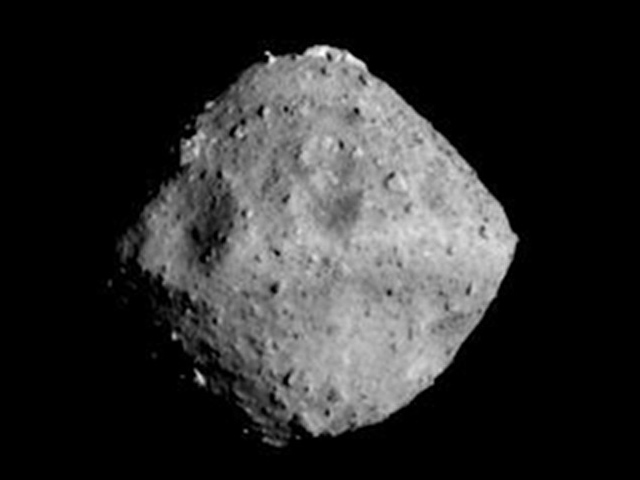
|
|---|
Jun. 20, 2018 Updated
JAXA signs Implementation Arrangement (IA) with Indian Space Research Organization (ISRO) concerning cooperation on validations, improvement, and applications of rainfall products using satellite images and ground measurements
|
JAXA and Indian Space Research Organization (ISRO) signed the Implementation Arrangement (IA) concerning cooperation on validations, improvements, and applications of rainfall products using satellite images and ground measurements. 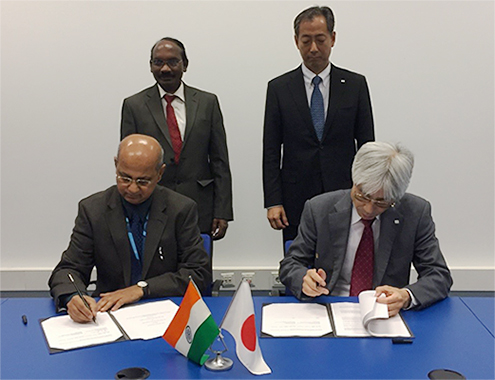
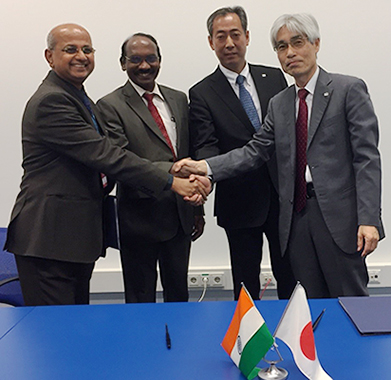
|
Jun. 19, 2018 Updated
Ryugu seen from 330-240km
|
The ONC-T (Optical Navigation Camera - Telescopic) captured images of Ryugu on June 17, 2018 at around 15:00 JST and June 18 at around 06:00 JST. At 15:00 JST on June 17, the distance to Ryugu was approximately 330 km, which had decreased to 240 km by June 18 at 06:00 JST. |
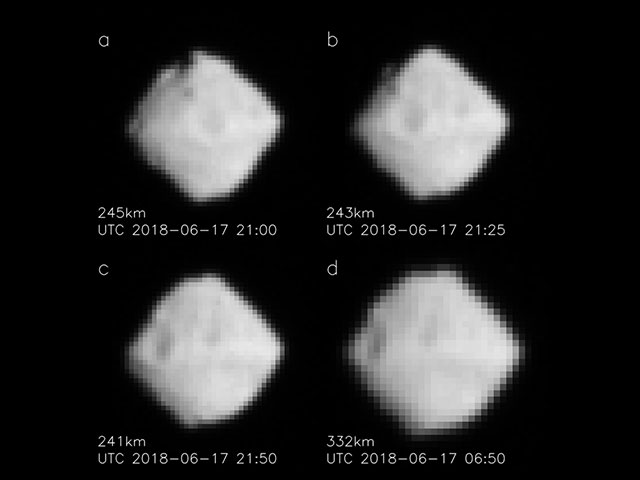
|
|---|
Jun. 16, 2018 Updated
From a distance of about 700km, Ryugu's rotation was observed.
|
Using the ONC-T (Optical Navigation Camera - Telescopic), asteroid Ryugu was photographed continuously from June 14, 2018 at around 21:00 JST through to June 15, 2018 at around 05:10 JST. Figure 1 shows a looped animation of the 52 captured images. |

|
|---|
Jun. 14, 2018 Updated
Ryugu seen from a distance of 920km
|
Hayabusa2 is steadily approaching asteroid Ryugu. Figure 1 shows a photograph of Ryugu taken on June 13, 2018 with the ONC-T (Optical Navigation Camera-Telescopic) from a distance of about 920km. The celestial body shining brightly in the center of the frame is Ryugu. The movement of Ryugu (in comparison to the background stars) can be seen by comparing this image with those taken on June 6 and June 10. The brightness of Ryugu is now about -6.6 mag (astronomical magnitude: a logarithmic scale for the apparent brightness for an object). |
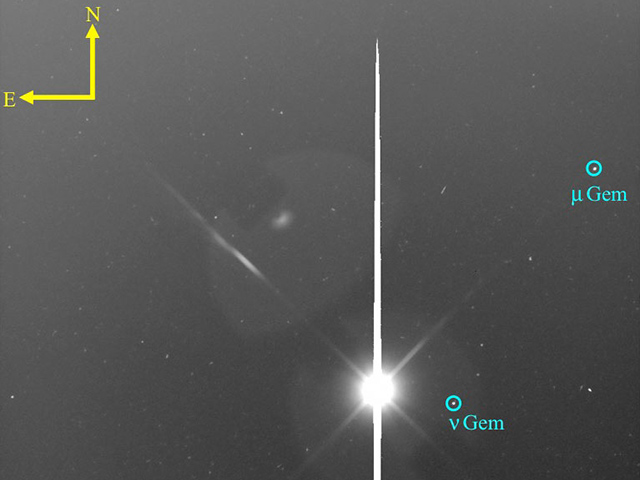
|
|---|
Jun. 8, 2018 Updated
MIO, MMO's New Name
|
JAXA selected MIO as new name for the Mercury Magnetospheric Orbiter (MMO) to be launched this Japanese fiscal year through March 2019. 6,494 responded to the two-month-long MMO renaming project. JAXA conveys gratitude for their participation. Starting this month, JAXA is giving the godparents a token of appreciation. Namesake and Background
Image: An artist rendering of MIO and Mercury |
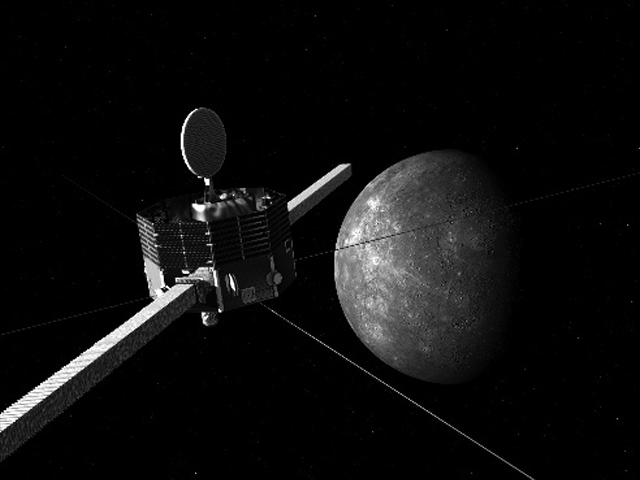
|
|---|
Jun. 7, 2018 Updated
Ryugu seen from a distance of 2600km
|
On June 3, 2018, ion engine operation was completed and the final approach to the asteroid begun. By photographing the asteroid with the Optical Navigation Camera, optical navigation (precisely “hybrid navigation using optical and radiometric observations”) can be used to approach Ryugu while accurately estimating the trajectory of the spacecraft and asteroid. |
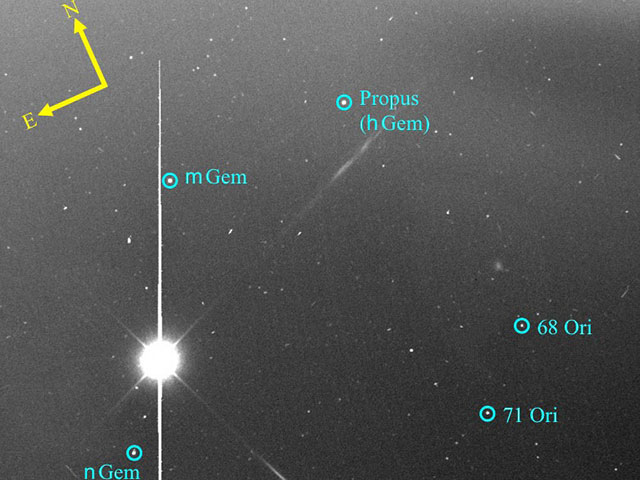
|
|---|
Jun. 1, 2018 Updated
JAXA President Meets with NASA Administrator and ROSCOSMOS General Director
|
On May 1, 2018, Dr. Hiroshi Yamakawa, JAXA President and Mr. Yoshimasa Hayashi, Minister of Education, Culture, Sports, Science and Technology met with Mr. Jim Bridenstine, Administrator of NASA at NASA Headquarters in Washington, DC. Dr. Yamakawa expressed his congratulations to Mr. Bridenstine on his appointment as NASA Administrator, and they exchanged views on US-Japan space cooperation including the International Space Station (ISS) program and the future space exploration. They also confirmed that they will further strengthen the cooperation between two agencies. In addition, Dr. Yamakawa and Mr. Masaji Matsuyama, Minister of State for Space Policy met with Dr. Dmitry Rogozin, General Director of State Space Corporation ROSCOSMOS at the Kremlin in Moscow by taking opportunity of the live communication event between two countries’ leaders and the ISS. Dr. Yamakawa expressed his congratulations to Dr. Rogozin on his appointment as General Director of ROSCOSMOS, and they confirmed that they will continue the good relationship and further strengthen the cooperation in the space field. 
(Right to left) Mr. Hayashi, Mr. Bridenstine, Dr. Yamakawa 
(Right to left) Dr. Rogozin, Mr. Matsuyama, Dr. Yamakawa |
April 2018
Apr. 19, 2018 Updated
JJ-FAST stops deforestation first time at rainy season in Brazil!
|
JJ-FAST team is developing a next-generation deforestation detection algorithm (version 2) to increase number of deforestation detection, and improve detection accuracy. To validate deforestation sites detected by the new algorithm, a JJ-FAST team visited some sites in Brazil on Feb. 22, 2018. When the team accompanied by IBAMA (Instituto Brasileiro do Meio Ambiente e dos Recursos Naturais Renovaveis) arrived at one site, a bulldozer was mowing down trees. Two forest loggers were caught red-handed, and the bulldozer was legally seized on site by IBAMA. The team and IBAMA officers also visited another site with ongoing deforestation on Feb. 26, 2018. When the team reached the site around noon, they found two large bulldozers connected with a massive metal chain left unattended. Bulldozers and chain mowing down trees is the typical method to clear-cut large areas quickly. Soon, three workers returned and stood in amazement when they found we waiting for them next to their bulldozers. The men were seized, and the machinery was confiscated on site by IBAMA. Being aware of the possible detection by optical satellites, they looked like they were wondering how their illegal deforestation activities were found under the cloud cover in rainy season. This validation activity was supported by two kind IBAMA researchers, Dr. Edson Sano and Dr. Daniel Freitas, and IBAMA local staffs in Sinop and Junia. The JJ-FAST team is very grateful for this wonderful cooperation with our counterparts in Brazil. |

|
|---|
March 2018
Mar. 26, 2018 Updated
Name the Mercury Magnetospheric Orbiter (MMO) and send your message to Mercury onboard MMO!
|
We are looking for the right name for the Mercury Magnetospheric Orbiter (MMO)*, whose upcoming launch is in October 2018, that will give a
relatable and familiar nickname so that everyone can follow our journey to Mercury. The person who suggests the selected name will recieve a
certificate and souvenir!
|
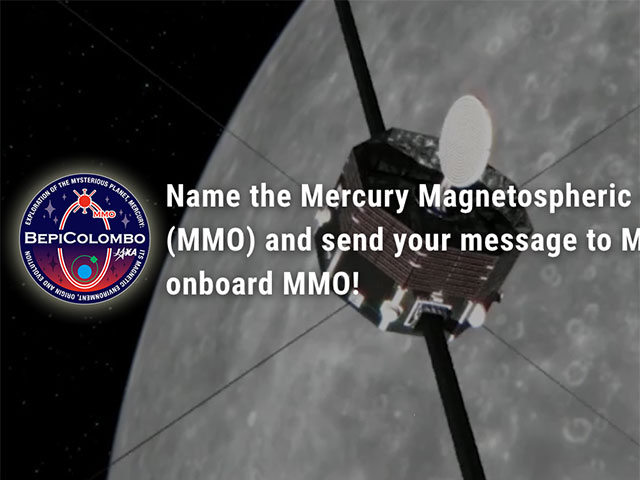
|
|---|
February 2018
Feb. 9, 2018 Updated
Tanker oil spill in the East China Sea observation by ALOS-2/PALSAR-2
|
In January 6, 2018, Iranian company's tanker "SANCHI" (Panama flag) collided with a cargo ship (Hong Kong flag) in the East China Sea off the east coast of China and a fire broke out. The tanker drifted into Japan's exclusive economic zone (EEZ) not being extinguished and exploded and sank at the sea about 315 km west of Amami Oshima in the afternoon of 14th. Oil is draining from the sunk tanker. |
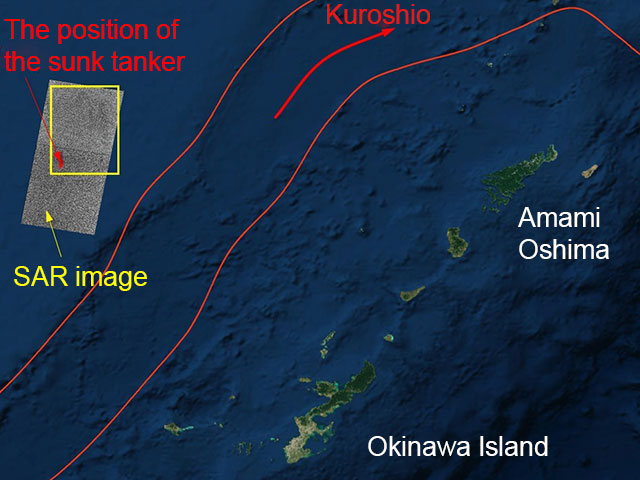
|
|---|
Feb. 6, 2018 Updated
Successful Launch Experiment, SS-520 No. 5
|
Exactly at 2:03 pm (Japan Standard Time) at the JAXA Uchinoura Space Center, JAXA experimented SS-520 No. 5 launch with a microsatellite TRICOM-1R aboard. |
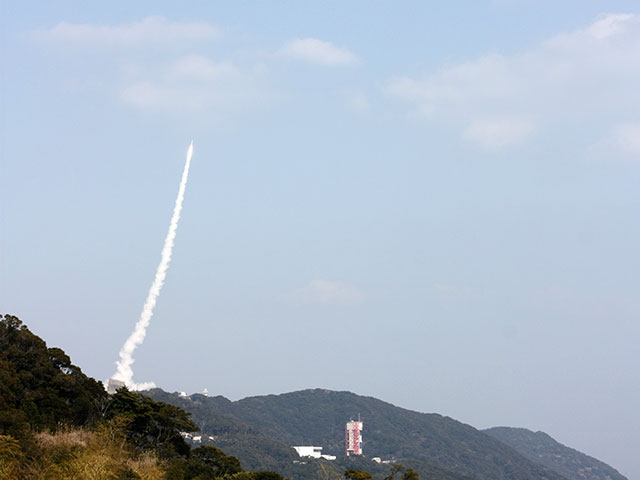
|
|---|
January 2018
Jan. 18, 2018 Updated
Success of Epsilon-3 Launch with ASNARO-2 Aboard
|
At 6:06:11 a.m. (Japan Standard Time) January 18, 2017, JAXA launched Epsilon-3, the third Epsilon launch vehicle which encapsulates NEC Small radar satellite "ASNARO-2", from the JAXA Uchinoura Space Center. The launch occurred on time. The launch and flight of Epsilon-3 took place normally. Approximately 52 minutes 35 seconds into the flight, the separation of ASNARO-2 proceeded, with confirmation as successful. |
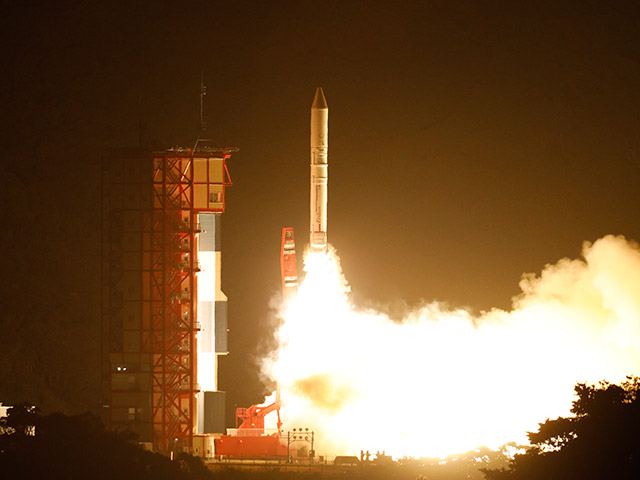
|
|---|
Jan. 12, 2018 Updated
First Light images from SHIKISAI (GCOM-C) were released
|
JAXA has released some observation images on the Earth acquired by the Global Change Observation Mission - Climate "SHIKISAI" (GCOM-C). The SHIKISAI was launched from the Tanegashima Space Center at 10:26:22 on December 23, 2017 (Japan Standard Time). These images are obtained by using the test radio wave transmitted from GCOM-C/SGLI on January 1st to 6th, 2018 (JST). |

|
|---|